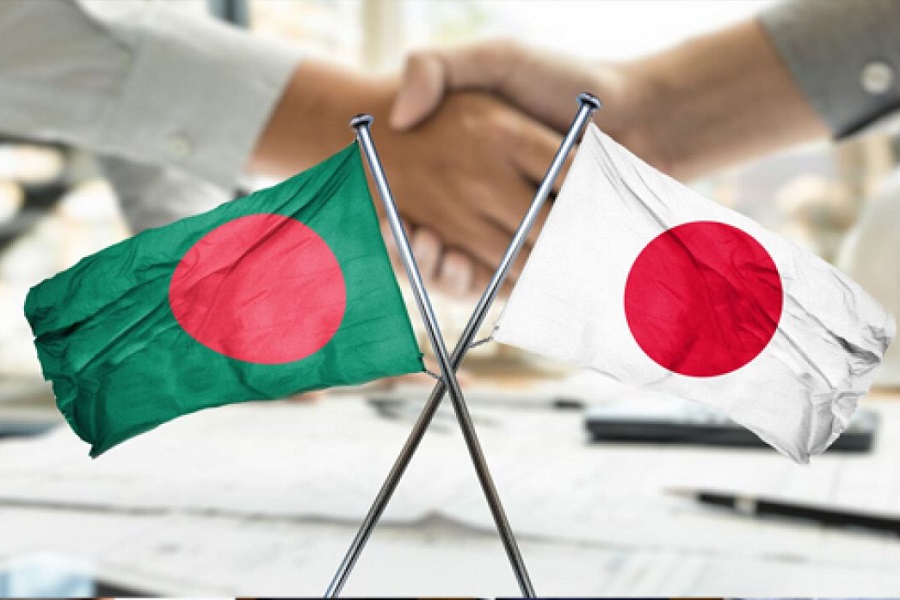BD-Japan FTA talks: Zero duty may impact Indian exports to Bangladesh
Indian think tank says in a report

Published :
Updated :

A report by Indian think-tank CUTS International (Consumer Unity & Trust Society) has warned India about the possible impact of the proposed Bangladesh-Japan Free Trade Agreement (FTA) on its trade with Bangladesh.
The report -- a quarterly analysis by CUTS Dossier on Preferential Trade Agreements and India released two days ago -- recommends that India "exercise caution and closely monitor the progress of the Bangladesh-Japan EPA negotiations."
CUTS International anticipates that India's exports to Bangladesh could be adversely affected if Bangladesh offers zero duty on all products to Japan under the FTA, which is scheduled to be signed by December this year.
"Several products in sectors such as automobiles, metals, electricals and textiles may be largely impacted by the Bangladesh-Japan FTA," according to the CUTS International analysis of possible scenarios.
As Bangladesh seeks to expand its trade relations with Japan, the CUTS report recommends that India assess the potential impact on its own trade interests and competitiveness in the region.
The report suggests that India may need to consider strengthening its existing trade ties with Bangladesh, diversifying its export markets, enhancing its competitiveness and exploring partnership opportunities to navigate the changing trade dynamics effectively.
The report said while India has a Preferential Trade Agreement (PTA) with Bangladesh and there is the Agreement on South Asian Free Trade Area (SAFTA), addressing these concerns is crucial to maintaining India's export performance in this market and neutralising the shocks posed by future FTAs that Bangladesh may engage in.
"This calls for a comprehensive economic cooperation agreement between India and Bangladesh," the report suggests.
Bangladesh is not a big competitor for India in terms of access to the Japanese market, as India already enjoys a tariff advantage in Japan due to its Comprehensive Economic Partnership Agreement (CEPA), according to CUTS International analysis.
However, the report warns that India should assess the possible impact of Bangladesh's fast-growing textile and apparel sector, including footwear, which is gaining a comparative advantage over time.
"As Bangladesh is entering into FTAs, India's textile and apparel industry should be concerned about their prospective market access challenges to third-country markets."
However, the CUTS International analysis using its SMART methodology suggests that India is unlikely to experience significant market share loss for textile and apparel products in Japan.
"Still it will be better to take some precautionary measures," the report cautions.
The analysis also suggests that any reduction in India's exports of certain textiles, apparel, and footwear to Japan would likely be negligible.
While Bangladesh's current export value to Japan remains lower than India's, the gap is narrowing due to Bangladesh's export growth. Bangladesh's exports to Japan reached $1.70 billion in 2022, compared to below $1 billion in 2013.
India's key exports to Japan include petroleum oils, fish products, non-industrial diamonds and ferro-silicon manganese, accounting for 42.76 per cent of its total exports to the country.
Bangladesh's exports to Japan are dominated by various types of readymade garments and footwear for both men and women, contributing 55 per cent of its total exports to Japan.
India's exports to Japan began a steady rise in 2016 after a three-year downturn in 2013-2015. This growth continued after the Covid-19 pandemic. However, the overall value of India's exports to Japan has declined, falling from nearly $8 billion in 2013 to $5.70 billion in 2022.
In March, Dhaka initiated talks to sign the Economic Partnership Agreement (EPA) with Tokyo in order to retain the duty benefit after Bangladesh's scheduled graduation to a developing nation in 2026.
The Bangladeshi authorities said the EPA with Japan will be signed before December.
If trade deals are not finalised before 2026, LDC-graduating Bangladesh will need to seek bilateral agreements with World Trade Organisation (WTO) member countries to continue enjoying duty-free market access until 2029.
The 13th WTO ministerial conference in Abu Dhabi last month extended duty-free benefits for graduating LDCs for an additional three years. However, Bangladesh will still need to negotiate bilateral trade deals to retain these benefits in the long term.
Therefore, Bangladesh is pursuing preferential trade agreements (PTAs) such as Economic Partnership Agreements (EPAs), Comprehensive Economic Partnership Agreements (CEPAs), and Free Trade Agreements (FTAs) with major trading partners.
In 2022, Japan imported approximately $1.72 billion worth of goods from Bangladesh, with over 90 per cent comprising apparel items like clothing and footwear.
Conversely, Japan exported $2.57 billion worth of goods to Bangladesh, with iron and steel accounting for around 30 per cent of these exports.
A study by the Japan External Trade Organization (JETRO) in May 2023 found that the number of Japanese companies operating in Bangladesh has doubled over the past decade, reaching 338.
These firms could face challenges if Bangladesh experiences higher tariffs exceeding 10 per cent for certain textile products after graduating from LDC status.
This situation marks a first for Japan, as it has never negotiated an EPA with a country on the verge of leaving its LDC status.
Initial research into a potential EPA with Bangladesh began in December 2022, and the findings recommended launching formal negotiations.
The research suggested that an EPA would not only boost trade and investment between Japan and Bangladesh but also strengthen their political and diplomatic ties.
Besides, Japan is also keen on setting standards for tariffs and trade regulations, particularly as Bangladesh considers a free trade agreement with China.
The negotiations will focus on simplifying import and export procedures, including reducing excessive paperwork.


 For all latest news, follow The Financial Express Google News channel.
For all latest news, follow The Financial Express Google News channel.